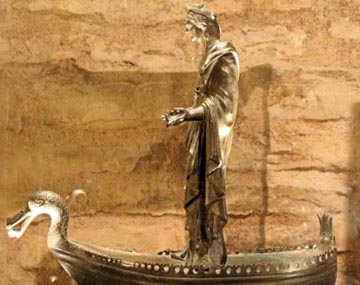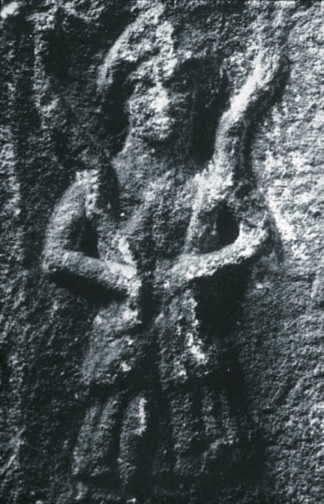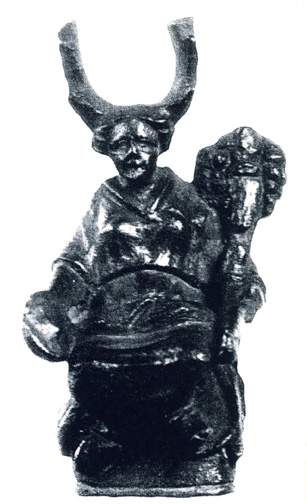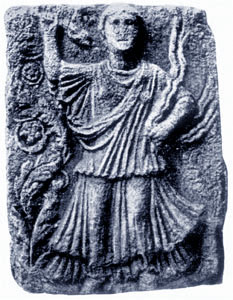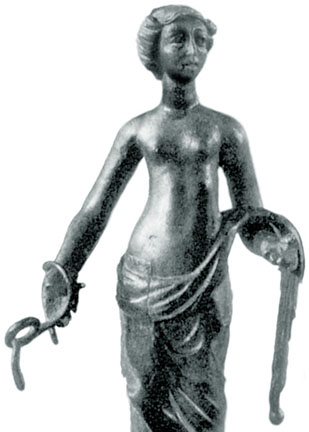Gaels and Gauls
Copyright 1998 Max Dashu
For love of the spirit ever persisting,
O Caticatona, be thou for thy servants
a powerful wave, for thy servants worship thee.
—Gaulish Goddess inscription [Markale, 120]Celtic deities were venerated as indwelling spirits of natural sanctuaries: the waters, rocks and peaks, groves, the land itself. A multitude of names in Roman-era inscriptions name the attributes of Gaulish goddesses: Artio (bear), Epona (mare), Nehalennia (sea), the Matres or Matronae (Mothers).
Groves were temples for the Indo-European tribes: the Germanic nimidas, Celtic nemeton, Latin nemus, Old Irish nemed or fiodh-neamheadh. The core meaning of the root word is “sacred.” Place-names show these sacred groves all over the Celtic world: Nemeton and Nemetodurum in France, Medionemeton in Scotland, Vernemeton and Aqua Arnemetiae in England, Nemetobriga in Spanish Galicia, and Drunemeton (“Sacred Oak Grove”) in Anatolian Galatia. [Chadwick, 6; Darrah, 109-11; O hOgain, 169; Ross, 36-7] In Italy, too, a sacred forest and lake at Nemi was the sanctuary of Diana Nemorensis. Celts invoked the goddess Nemetona at Pfalz, Germany. [Rutherford, 66-7] Altars were dedicated to Nemetona and Lightning at the hot springs of Bath, England.
Many sacred woods were named after goddesses. The Black Forest originally borethe name of Abnoba, and the Ardennes forest still is named for Arduinna, shown riding a boar in a Roman-era sculpture. [Markale, 93] If the names have not always survived, the veneration is well-documented. Tacitus wrote that the northern barbarians worshipped the “Mother of Gods” in an oak grove. [Darrah, 80] Another great Gaulish grove was the forest of Marseilles, sacred to “Diana.” Greek settlers had founded a cult of Artemis at Massilia, but undoubtedly the native goddess predated, and merged with her. Lucanus' famous description of this Gaulish grove says that dragons wound themselves around its oaks, which were stained with sacrificial blood. He wrote of caverns that roared at the earth's movement, and flames that did not consume the wood. [M.A.R, ///; MacCullogh, 11]
For centuries the Gauls refrained from cutting any trees in the Marseilles grove. Even the Roman conquerors were afraid to bring woodcutting tools into it, because of a belief that the axe would return to injure anyone who desecrated the sanctuary. Similar traditions protected sacred trees all over the continent. Anyone who cut them down was struck with palsy or other ailments. [Sebillot, c 267 ff]
Celtic peoples revered the waters. Across Europe they approached springs and lakes as sanctuaries and places of healing, throwing in offerings and cultic healing images of carved oak. Archaeological excavations indicate that this custom goes back to the early La Tene cultures. Terracotta goddess figures from a later period have been recovered from French lakes. [Thevenot, 210] Strabo wrote that the Gauls threw gold and silver into a sacred lake near Toulouse to honor its divinity. The early christian writer Gregory of Tours described how the peasants of Gabales brought offerings of cloth, loaves and cheese to drop into a lake in Lozère. They sacrificed animals there, feasting and celebrating for three days. A temple had been built there in Roman times. [Thevenot, 210]
Indo-European peoples named major rivers after Danu, Sinann, and other goddesses. The Marne in northern France was named Matrona in the first century BCE. The eastern Gauls built some twenty monuments to the goddess Nantosuelta, whose name meant “winding river.” [Thevenot, 167; Ross, 219-20] Shrines grew up along the shores of the Severn (named after the goddess Sabrina) in Wales and at the source of the Seine, named after the goddess Sequana. [Ross, 22] The Gauls made pilgrimages there to pray to Sequana for healing, casting votive tablets and oaken images of humans, animals, and afflicted body parts into her spring. A bronze from Sequana's temple shows a Romanized goddess standing in a boat, spinning. Her vessel is shaped like a duck with a berry in its bill. [Ross, 109]
Sequana in her duck-ship, in the creative act of spinning, from her sanctuary at headwaters of the Seine river, France
From Spain to Switzerland to Britain, the Celts held springs sacred to healing goddesses. In the lower Alps they were consecrated to the Griselicae Nymphae. Further north, the sacred healing springs of Alesia appear to have been linked to the “Mothers” of a surviving altar tablet. All over Gaul stone tablets inscribed to the “Mothers” were connected to spring sanctuaries. The goddess Sirona or Tzirona was connected to healing fountains over a large area of Gaul. One of her temples stood at the lakeside at Sainte-Fontaine in Freyming (Moselle). [Thevenot, 104, 189, 210]
Some of these springs lived on as holy places into modern times. In Savoy a healing fountain goddess was thinly christianized as Notre Dame de la Vie. Her stone statue holds a vessel over her belly from which heavy drops of water spill. People came to the shrine to bathe in its waters, which were believed to be healing. The image is sculptured in the ancient Celtic La Tène style, and in fact the high valley of Doron de Belleville is full of early La Tène sites. [Thevenot, 191-4]
A British priestess, or the goddess Verbeia herself, brandishes serpents on an altar stone. This goddess is the namesake of the river Wharfe in Yorkshire. Similar snake-wielding women appear in Canaanite, Iranian, Cretan, Maya, Scandanavian, Yoruba and other West African art.
Anne Ross has shown that a healing goddess presided over thermal springs across the Celtic world. She cites the Gaulish sanctuary at Mavilly, where an altar stone shows an entranced priestess dancing with serpents, and the British sanctuary at Baxton, Aquae Arnemetiae, named for the curative waters of the goddess Arnemetia (“highly sacred”). [Ross, 218]. A Welsh temple at Caerwent (Venta Silurum) seems to have been a healing center with thermal springs. Its stone goddess with fruits and greenery is carved in the archaic, pre-Roman style and prefigures the later classic sheila-na-gigs. [Ross, 191-2; pl. 69]
Under Roman rule, the Celtic healing goddess was often represented as Minerva, but retained her native names, such as Brigantia (“exalted, high one”) or Sul (“sun”). [Sul later gained a derivative meaning of “eye” in Irish. McCone, 164-5] In some places this goddess was assimilated to Kybele, an Anatolian goddess who was also connected with healing and thermal springs. [Gasparro, 87, cites a Phrygian inscription calling Kybele Meter Thermini, “mother of the hot springs.”] Emile Thevenot presents corroborating evidence in his studies of Gaul. The thermal springs of Allègre (Gard) were consecrated to the Nymphs of Fumades. A stone relief from the sanctuary shows three Matres with a sheaf of grain, a basket and a cornucopia; another shows spinning goddesses. [Thevenot, 202] At Lhuis (Ain) a temple inscription honors the Healing Mothers, personifications of a nearby stream. There are hints that the Comedoves at Aix-les-Bains also had medical powers. [Thevenot, 203, 189, 166]
Priestesses called “Mothers” kept a perpetual fire burning at the mineral springs at Bath. In Roman times the place was called Aquae Sulis, the “waters of Sul.” The name Sul originally derives from the ancient Indo-European sun goddess—Sol in Latin and Germanic tongues, Saulé in Lithuanian, and more distantly, to Indic Surya. In Britain, the goddess Sul infused the hot springs with healing power. “In her temple perpetual fires burned and never grew old, for where the fire wasted away it turned into shining globes.” [Maccullogh, M.A.R., 11] Her temple was the greatest of Britain's Celtic shrines, attracting large numbers of pilgrims to its hostelries and market. Votive inscriptions at Aqua Sulis also honored Nemetona, Diana and Rosmerta. [Webster, 129?]
The priestesses of Sul were called Suleviae, a Latin name that means “reliever, soother.” This fully accords with the shrine's reputation as a place of healing. Altars to the Matres Suleviae have turned up at Camulodunum, Binchester and Cirencester in northern Britain. Suleviae were also found in Gaul and far to the east, in what is now Rumania. [Webster, 128?; Thevenot, 166]
A British inscription at Irthington honors the deae Nymphae Brigantiae, the nymphs clearly signalling the presence of sacred waters. The Braint and Brent rivers were named after Brigantia. Wells in both Ireland and Britain were named after a related goddess, Brigid. [Ross, 218, 210, 231, 213, 360-1] A temple over a spring at Carrawburgh, Northumbria, remained active into the 4th century. Its goddess Coventina pours out the waters of her fountain from a vessel. On another relief she wrings out her hair—the symbol of a rain-making goddess in many countries, from Russia to Cambodia—while skyclad nymphs around her pour libations. [Chadwick]
Though we have few written sources about the priestesses of these water-sanctuaries, later oral tradition remembers them. British legend speaks of “the nine sorceresses or fairies of Gloucester, who guarded the thermal waters of that ancient city.” [Spence, 63] Similar shrines existed in Ireland. Irish tales often refer to “buildings being erected over sacred wells, the source of rivers...” [Ross, 232]THE SENAE AND GALLICENAE
Priestesses lived on numerous island sanctuaries in the Celtic fringe of western Europe. Old writers refer to the Witch of Iona and the Sibyl of Warinsey on the island of Guernsey. [John Rhys, CF] The Norse lays of Helgi also refer to hags or sibyls on the Channel islands. [Spence, 63] Folk tradition held that the tidal island of Mont St Michel had a college of female druids who “distributed to the faithful amulets which possessed marvelous properties and arrows which never missed their mark.” [Cauzons, 68]
Nine unmarried priestesses lived on the holy island of Sena (modern Sein, off the southwest coast of Bretagne). The island's name means “breast.” The Roman writer Pomponius Mela wrote that people made pilgrimages to this island to consult the Senae and to be healed by them. They were believed to possess special powers:to rouse the seas and the wind by their incantations, to turn themselves into whatever animal form they choose, to cure diseases which among others are incurable, to know what is to come and to foretell it. [De Situ Orbis]
The Senae were guardians of a sacred Cauldron in which, like the goddess Cerridwen, they simmered mysterious herbs to produce a drink of immortality and resurrection. [also: Chorographia, III vi, 8, in Chadwick]. This theme of multiple female guardians of a holy cauldron (“warmed by the breath of nine maidens”) is repeated in early Welsh poems. The Senae possess all the elements of shamanism: chants, prophecy, healing, weather-making powers, and shapeshifting. The cauldron resonates with later-recorded traditions about witches, themselves closely associated with prophecy, healing, and shapeshifting.
Strabo relayed reports from the lost writings of Poseidonius about a Gaulish island of women at the mouth of the Loire river, in the land of the Namnetes. Its ecstatic priestesses (“Gallicenae”) celebrated religious mysteries there. (The name adds the word "Gaulish" to the original title of Senae, which would be something like "breast-women" in Latin.) No men were allowed on this narrow island. The women with husbands visited them on the mainland on appointed nights, always returning before the morning star shone. Every year they had to tear down their temple and rebuild and thatch it between the rising and setting of the sun. [Chadwick, 135; Strabo IV, 4; Cauzons, 67] The Greeks seem to have added a Dionysian twist, saying that if any woman let some of the materials fall, the others would tear her to pieces. (We're left to wonder how they knew this since not even local men visited the sacred island.) Such islands of women were a frequent theme in the Imrama genre of Irish poetry. [Chadwick/Dillon, 135]
Goddess or priestess with antler headdress. She holds the cornucopia and libation-bowl, attributes of Fortuna and Bona Dea. Bronze statuette, Britain.
Roman men alluded to the shamanic rituals of Celtic women, but were unable to describe them in detail. Pliny wrote that British women attended their rites “in a state of nature,” their naked bodies painted blue-black with woad. [Natural History, xxii, in Webster, 146fn; Grimm] Another Roman source refers to wild women soothsayers among the druids on the Welsh island of Mona (Anglesey, off the coast of Wales). [Spence, 61-2.]
A couple of Celtic altar stones show shamanic priestesses dancing with snakes. A stela from Mavilly, France—another thermal fountain site—shows a robed woman with two snakes in her left hand and a ceremonial object in the right. An altar relief from Yorkshire, the goddess Verbeia—or her entranced priestess—grasps a huge snake in each hand. [Ross] Gaulish sculptures show the goddesses Sirona and Rosmerta with snakes. [Thevenot; Webster, 58]
Gaulish priestess dancing with snakes. Mavilly, France. Early centuries CE.
A Roman epigraph at Antibes refers to a Gaulish antistita (priestess) of the goddess Thucolis. Other antistitae are named in inscriptions at Arles and Metz. [Arete Druis Antistita, somno monita, Spence, 61] Roman accounts mention a “Gaulish divining druidess” (druias Gallicana vaticinans), and a “divining woman of the Chatti tribe.” [the former: Aur. 44, no. 13-4, both in Grimm, 1318] Another Latin source recounts that “the female druids [druidae] made two splendid fires with great incantations over them, et ducebant greges quos cogebant transire per eos ignes.” [Grimm, 1466]
Irish priestesses also kept sacred fires. In pagan times the virgins at Kildare were called Ingheaw Andagha, “daughters of fire.” [Spence, 61] An old Irish expression, tine tlachdgha (“Tlachtga's fire”), links a sacred fire to a great sorceress of the Tuatha De Danann. [Grimm, 1318?]
UIDLIUA, VELEDA, FILI
A rare Gaulish inscription on a lead plaque found in a tomb at Larzac makes reference to a sisterhood of enchantresses. It comes in the form of a spell containing the phrase bnannom bricto, "women’s spell." This word for "spell" or "charm" appears in another Gaulish inscription as brixtia anderon, "magic of the underworld." Both forms of this word appear to be related to the name of a goddess of oaths, Bricia or Brixia, known from other inscriptions at Luxeuil. [Lambert, 154, derives these spell-names from IE *bhregh, "to declare solemnly.”]
The Gaulish text is still imperfectly understood, but linguist Yves Lambert summarizes it as an appeal to the goddess Adsagsona against a group of women who got a witch, Severa Tertionicna, to influence judges in a trial that the supplicant was involved in, and to turn back the spell they cast. [Lambert, 172] The first line is interesting: "Send the charm of these women against the names below: this [is] a witch charm bewitching witches," or alternatively, “of a bewitching witch." In Gaulish, it reads, brictom uidluias uidlu[as] tigontias so.
This is where it gets really interesting. Lambert derives uidliua, witch, from Old Celtic *uidlmâ [macron on a], and ulltimately from the Indo-European root *wid-, "too see, to know." In other words, it has the same origin as the Russian word for witch, vyed'ma, and the Sanskrit Vedas, as well as Irish and Welsh words for seer-poets (fili, gwelet). Within the Celtic realm, Lambert compares this "seeress" name to that of the legendary Irish prophetess Fedelm. [167] As we'll see in a later chapter, the Bructerii (Netherlands) had a seeress Veleda who led a revolt against the Roman empire in the first century CE. Although Roman writers reported Veleda as her proper name, it was clearly a title with etymological and cultural links to Gaulish, Irish,
Another intriguing aspect of this charm appears in the next lines: "O Adsagsona, look twice at Severa Tertionicna their witch of thread and their witch of writing." The last nine words are only two in the text: lidssatim liciatim. [165] Lambert convincingly explains liciatim as derived from Latin licium, "yarn," and much less firmly, lidssatim from littera, "writing." He notes an example from Ovid of a spell executed by using both: writing on lead and tying enchanted yarn around it. The Gaulish charmed lead sheets copy classical tradition, and use Latin letters. Before romanization, the Gauls had no written tradition. But the liciatim element—the yarn-witch—resonates with an broader, older Celtic (and pan-European) context: the magical valence of spinning and weaving. The seeress Fedelm, after all, holds a weaver's beam as she prophesies, and there are countless instances of magical spinning and weaving in pagan European custom.
Finally, there is the list of a dozen women whose bewitchment is sought in the lead sheet of Larzac, the ones responsible for casting the original spell for which this is the counter-spell: "Let the women named below, spellbound, be for him reduced to powerlessness." Most of these women are listed as "mother of" or "daughter of" another woman. Lambert finds this use of the matronymic puzzling, since Gaulish society generally named both males and females patrilineallly. [168-9]
Sirona, the goddess of healing springs, with her serpents. Gallo-Roman silver-plated bronze (with Apollo).
Michel Lejeune has proposed that we are looking at a sisterhood of witches, a magical society in which "mothers" and "daughters" are not biological but cultic. There are certainly plenty of examples of worldwide of the ritual address of senior priestesses and initiators as "mothers." Lambert objects, "Why would there be three sorceresses who called themselves 'mothers' of another sorceress?" [169] But this would be even more improbable in the case of biological motherhood! Either Lejeune is right, or we are looking at a pocket of matrilineage similar to the custom that survived up to the 15th century in Jeanne d'Arc's village, where daughters took their mother's surname.
Roman sources report “female druids” (druidae) in encounters with their colonial armies. Flavius Vopiscus relayed a story about Diocletian’s encounter with one of these women who prophesied his rise to become emperor. Other stories about emperors and druidae were recorded in the 4th century Scriptores Historiae Augustae (www.digitalmedievalist.com/faqs/bandrui.html).
Old Irish literature also speaks of these female seers. [Joyce, ch V] The fáith or ban-fáith was a prophetic woman “expert in super-natural wisdom.” [Chad/Dillon, 153] She was also called ban-filid, ban-filé (words that have the same root as uidliua), ban-drui or ban-draoi, “druid-woman.” [Book of Leinster, in Spence, 60-1; also Goodrich, 348] The epics say that the ban-drui Bodmall raised Finn MacCumhal “in the wilderness,” while another—named Milucrah, “Hag of the Waters”—used lakewater to change him into an old man. [Spence, 61]
Another legend mentions the female druid Biróg, who helped Kian by magically transporting him and herself across the sea. Women of the Tuatha Dé Danann are often described as performing magical and prophetic acts. The three daughters of Calatin created a spectral army out of dead leaves and puff-balls to flush an enemy warrior out of hiding. [M.A.R., 154-6]
Imbas forosnai (“knowledge that illumines”) was originally “the special metier of women,” according to Nora Chadwick. She pointed to its female context in early works. In the Druim Snechta, the British witch Scathach practiced imbas forosnai. According to the Táin Bó Cualgne the Irish prophetess Fedelm went to Britain to study this art. She comes from the mound of Cruachan, and queen Medb asks her to foretell how the coming war will go. The banfaid “looks,” and chants in verse her vision of a disastrous defeat, “at considerable length”. Later sources, however, usually link imbas to the male hero Finn mac Cumhal and to the male filid. [Chadwick, 1935]
Irish accounts present Scathach as not only a prophetess (fáith) and a druid but also a teacher of martial arts. The same is true of the warrior-seeress Aoife. In the story of Peredur, the Welsh Mabinogion mentions nine gwiddonod who ran a martial arts court at their parents' homestead in Gloucester. [Chad/D, 153] Legend recalled a sanctuary of women druids at Cluan-Feart, though they have been demonized as sorceresses with the power to cause storms, disease and death. [Spence, 61] Irish women also acted in courts of law, as indicated by the female legal title Brig. We read of Brig Bretach, “druidess of the judgement.” Brig Ambui, daughter of Senchad, argued a case of female rights. [Grimm, 347] The historic religious leader Brigid “pronounced judgements on female covenants.” [Condren, 63]
Irish tradition places much emphasis on the geis (pron. gaysh) an ancient power of the word which was “a special privilege of women.” Laying a geis on someone most frequently involved a ritual taboo of some kind: avoidance of foods or actions or associations. Originally it would have been a priestess or female sovereign or clan mother who imposed the geis. It occurs in this form in the Welsh epic of Kullwych and Olwen. The hero’s stepmother lays a tynghet, literally a “destiny,” upon him: “I swear thee a destiny that thy side touch not a wife till thou obtain Olwen.” Arianrhod does the same in the tale of Llew. Tynghed also meant fate or fortune, and tyngu tynghed, to “swear an oath.” [Rhys II, 647, 644, 649]
Early Irish literature shows the kings of the ceremonial capital,Tara, as constrained by various geassa. Powerful warriors such as Cuchulain and Fionn mac Cumhaill also observed these personal taboos. In late romances, women used them to constrain men to do their will, as Deirdre forced Diarmaid to elope with her. [O hOgain, 237] The power of the word was often described in stories of female satirists.
Boilce, a satirist of the Britons, put a geis on Luightheach to lie with her. She bore Conall Corc, who was fostered by the sorceress Feidhilm (there’s that title of Fedelma again). He came to be called Corc mac Laire after her nickname, Red Mare. It was said that she once hid the boy under the hearth when a group of sorceresses came to her house. One of them said, “I destroy only what is under the cauldron,” and fire seared his ear. This seems to have been interpreted as a kind of initiatory endowment of power. The next day a diviner looked at Corc’s palm and foretold that he would become famous if only he freed captives whenever he could. [O hOgain, ///]
[Excerpted from unpublished MS by Max Dashu, Secret History of the Witches]
Home | Catalog | Articles | Secret History of the Witches
